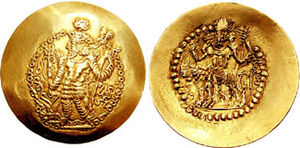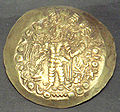Kushano-Sasanian Kingdom Kushanshahr | |||||||||||||
|---|---|---|---|---|---|---|---|---|---|---|---|---|---|
| c. 230 CE–c. 365 CE | |||||||||||||
 Map of the domains governed by the Kushano-Sasanian Kingdom | |||||||||||||
| Capital | Balkh | ||||||||||||
| Common languages | Middle Persian Bactrian | ||||||||||||
| Religion | Buddhism Zoroastrianism Hinduism | ||||||||||||
| Government | Feudal monarchy | ||||||||||||
| Kushanshah | |||||||||||||
• 233-245 | Ardashir I Kushanshah | ||||||||||||
• 330-365 | Varahran Kushanshah | ||||||||||||
| Historical era | Late Antiquity | ||||||||||||
• Established | 230 CE c. 230 CE | ||||||||||||
• Disestablished | c. 365 CE | ||||||||||||
| |||||||||||||
| Today part of | Pakistan Afghanistan Turkmenistan | ||||||||||||
The Kushano-Sasanian Kingdom (or Indo-Sasanians) was a polity established by the Sasanian Empire in Bactria during the 3rd and 4th centuries. The Sasanian Empire captured the provinces of Sogdia, Bactria and Gandhara from the declining Kushan Empire following a series of wars in 225 CE. [1] The local Sasanian governors then went on to take the title of Kushanshah (KΟÞANΟ ÞAΟ or Koshano Shao in the Bactrian language [2] ) or "King of the Kushans", and to mint coins. [1] They are sometimes considered as forming a "sub-kingdom" inside the Sasanian Empire. [3]
Contents
- History
- Religious influences
- Coinage
- Kushano-Sasanian art
- Artistic influences
- Main Kushano-Sassanid rulers
- See also
- References
- Sources
- External links
This administration continued until 360–370, [1] when the Kushano-Sasanians lost much of their domains to the invading Kidarites; the remainder was incorporated into the Sasanian Empire proper. [4] Later, the Kidarites were in turn displaced by the Hephthalites. [5]
The Kushanshahs are mainly known through their coins. Their coins were minted at Kabul, Balkh, Herat, and Merv, attesting the extent of their realm. [6]
A rebellion of Hormizd I Kushanshah (277–286 CE), who issued coins with the title Kushan-shahanshah ("King of kings of the Kushans"), seems to have occurred against contemporary emperor Bahram II (276–293 CE) of the Sasanian Empire, but failed. [1]
















